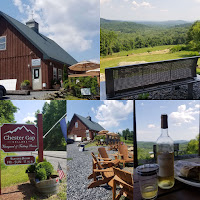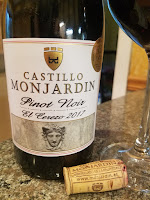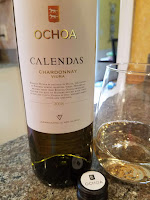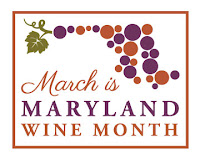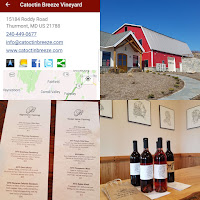"In 1395 Philip the Bold, Duke of Burgundy, ordered that all Gamay vines be uprooted by the following Easter. The Duke believed the cultivation methods used in raising Gamay were damaging the reputation of Pinot Noir. Although the decision sparked such uproar among the public, the Duke’s attempts at eradicating Gamay were thorough, enforcement of his ordinance did not reach Beaujolais in the very south of Burgundy, where pockets of the grape continued to grow.", Discover Beaujolais
And Gamay held on in these pockets quietly, until 1937 when Beaujolais became a Protected Designation of Origin (PDO). At last, Gamay was finally recognized as that region's protected grape. Gamay is a cross between Pinot Noir and Gouais Blanc and it was originally brought to the area from Croatia by the Huns in the 4th century. Beaujolais is located north of Lyon in eastern France and actually overlaps Burgundy in the north and Rhône in the south. The vineyards sit on mostly granite terrain that overlooks the Saône River. The soils provide minerality and structure whereas the abundant sunshine and warming influences from the river provide complete fruit maturation.
The region consists of a dozen appellations which include 10 Crus - the "jewels" of Beaujolais where Gamay is the heart and soul. According to
Discover Beaujolais, expect fine and flavored profiles from Brouilly, Chiroubles, Fleurie, Régnié, and Saint-Amour and intense and generous profiles from Chénas, Côte de Brouilly, Juliénas, Morgon, and Moulin-à-Vent. The two other appellations are Beaujolais and Beaujolais Villages and both permit red, white and rosé wines. The Beaujolais appellation is the widest covering about 24 square miles in the south and east. Vines in this appellation grow in limestone-clay and granitic soils around 72 villages and provide 65% of Beaujolais Nouveau. Beaujolais Villages accounts for the remaining 35%, is the second widest region, and is divided into three zones. "The southern zone is near the Haute-Azergues hills and has soil that produces very fruity wine. Wines with greater structure are made in the central zone, and the northern area is known for its full-bodied wine."

Beaujonomie is the assertion that good wine should be enjoyed over a shared table with lively conversation and delicious food. And Discover Beaujolais is using 2019 to introduce this concept to American consumers through various Beaujolais Road Shows, one which just presented in New York City and Washington. Seventeen Beaujolais wineries conversed with attendees describing their operation, vineyard, the crus, appellation, and anything else relevant to the winery.

Being a warm afternoon, Beaujolais blanc (Chardonnay ) was an appropriate starting point. At
Domaine Louis Tête, current winemaker Jean Tête and his daughter Justine have a pedigree dating from the early 1800s when their family first planted vines in “Les Dépôts” (a few kilometers from Beaujeu the historical capital of Beaujolais). Thus Louis Tête is the oldest brand in Beaujolais and their
2018 Beaujolais Blanc is tart with a green apple profile and refreshing acids. In contrast, the
Domaine Piron 2018 Beaujolais Blanc is more saline driven with a more citrus and pineapple profile. Granite soils seem to be in play here. This winery has an even longer winemaking pedigree as the co-owner Dominique Piron’s oldest known ancestor, a future winemaker, was born in Morgon en 1590. Co-owner Julian Revillon is very proud of this wine as well as his cru wines and provided an introduction to
Morgon (the second largest cru) and Chénas (the smallest). The decaying volcanic soils in Morgon help create elegant wines with racy acidity and solid tannic structure as evident by the
Domaine Piron Morgon Cote du Py 2017. And in
Chénas, granitic soils are covered with Quartz crystals providing similar minerality in the
Domaine Piron Chénas Quartz 2016 that combine with floral and stone fruit notes and rounded tannins. Excellent.

Cécile Dardanelli presented several
Domaine Bel Avenir wines from various Beaujolais crus including the
Morgon Les Charmes 2017 and the
Chénas Grand Guinchay 2107. The Morgon was very fruit forward providing fresh acids and the Chénas was juicy and solid tannic structure both in contrast to the Domaine Piron. The highlight from this 4th generation producer was their
Fleurie Poncié 2017 that was silky with easy tannins. The soils in
Fleurie are predominately pink granite and the vines benefit from exposure to warm morning sunshine during the growing season.
Moulin-à-Vent lies just north of Fleurie and
Domaine de la Fond Moiroux showcased the cru through a vertical from 2016 back to 2009. The 45-year-old vines are planted on similar pink granite soils but differ with Fleurie due to large manganese deposits. These wines were intense with dense fruit and varying degrees of acidity that allowed the wine to remain fresh through most of the eight years.
 P. Ferraud & Fils
P. Ferraud & Fils poured the best Moulin-à-Vent of the tasting in their
Moulin-à-Vent La Dynastie Des Ferraud, 2015 -- very dense and intense fruit -- but the
Saint-Amour, Cuvée Ensorceleuse 2017 from this 5th generation winemakers was also delicious. It had more fruit character - berries and even some stone fruit - but a nice structural backbone laced with minerals. The terrain in this most northern cru is hilly with clay and loam soils augmented with granite and limestone.
Juliénas lies adjacent to Saint-Amour but provides heavier wines than its neighbor. "The terroir of Julienas is often considered to be the most variable in the Beaujolais region. The soils are transitional, ranging from granite further up the hills in the west to more sedimentary and alluvial in the east nearer the river". Chateau de Julienas dates from the 14th century when it was a winemaking estate owned by the Lords of Beaujeu. In 1907 Claude Condemine bought and restored the Chateau and improved the vineyard and today it is managed by his grandson Thierry. Their
Chateau de Juliénas- Juliénas Tradition 2016 is a well-balanced wine starting with tart red cherries transitioning to a rustic pepper character and finishing with fresh acidity.
 Régnié
Régnié is the youngest cru, gaining that status in 1988 after being part of the larger Beaujolais Villages appellation. It is known for lighter wines, fragrant and structured, with refined tannins. The cru shares the common pink granite soils but at some of the highest terrain within Beaujolais.
Chateau de Durette is also relatively new, with Marc Theissen crafting the first wines a decade ago. The vines for their
Régnié Les Bruryeres 2018 are 60-70 year-old vines planted next to the winery and Theissen utilizes a new regulation allowing for the labeling of single vineyards. Thus the home vineyard of "Les Bruyères" is proudly displayed.
Like Régnié, the
Chiroubles cru is a cooler climate because of its higher altitudes and provides lighter and fresher styles of Gamay. The granite soils come into play in Chiroubles reflecting heat that warms the grapes in cooler conditions. Fabien Collonge is a young winemaker (23 years old) but in terms of the
Domaine Fabien Collonge Chiroubles L'Aurore des Cotes 2017, crafts wines worthy of more established producers. This wine is noted for its savory fruit and a rounded mouth-feel finishing with refreshing acidity.
Brouilly is the southernmost cru and is known for their robust and full-bodied wines characterized by the
Domaine Ruet Brouilly Vielles Vignes 2016. There is a range of mesoclimates and soils composition in the vineyards of Brouilly so there is plenty of differences of wine profiles within the cru. Domaine Ruet is now on its 4th generation winemaker and this one comes from 60-100-year-old vines planted in pink granite soils of Voujon, Les Grands Bruyères. This is an elegant wine, candied cherries and raspberries, with traces of minerality and chewy tannins.
Côte de Brouilly is surrounded completely by the much larger Brouilly appellation and is known more concentrated wines with less earthiness than those from its neighbor. The soils contain diorite, a blue stone that results from ancient volcanic activity. These thin, stony, and occasional clay soils are well drained and lack water and nutrients which result in small but highly concentrated berries. Wines like the
Cave du Chateau Des Loges, Côte de Brouilly Prestige 2017 provide dense fruit, tannic structure, and in this specific case, once again stone fruit.
 In 1793 the town of New Market was founded by Nicholas Hall Sr. and William Plummer as a rest and trade stop along the Baltimore Turnpike wagon trail. The two gentlemen understood the commercial value of the turnpike and turned a half-mile section of the trail into New Market’s Main Street. In twenty years the town had grown into an important trade center for wagoners and other travelers and included "a button factory, nail factory, wheelwright shops, blacksmith shops, tanneries, dry gods, grocery stores, inns, taverns, livery stables, wagon stands, " and most importantly -- distilleries. In 1818:
In 1793 the town of New Market was founded by Nicholas Hall Sr. and William Plummer as a rest and trade stop along the Baltimore Turnpike wagon trail. The two gentlemen understood the commercial value of the turnpike and turned a half-mile section of the trail into New Market’s Main Street. In twenty years the town had grown into an important trade center for wagoners and other travelers and included "a button factory, nail factory, wheelwright shops, blacksmith shops, tanneries, dry gods, grocery stores, inns, taverns, livery stables, wagon stands, " and most importantly -- distilleries. In 1818:


 Eventually, the railroad and the automobile would reduce the trade and rest stop significance of New Market -- but not its historical significance. And on December 6, 1975, the Town of New Market was placed on the National Register of Historical Places and under the supervision of the Department of the Interior.
Eventually, the railroad and the automobile would reduce the trade and rest stop significance of New Market -- but not its historical significance. And on December 6, 1975, the Town of New Market was placed on the National Register of Historical Places and under the supervision of the Department of the Interior. When she and her husband Howard inherited the property they drained their 401K accounts and planted Cabernet Franc, Cabernet Sauvignon, Chardonnay, Merlot, Muscat Blanc, Petit Verdot, and Syrah vines in 2012. Their first harvest occurred two years later and the estate was christened New Market Plains Vineyards.
When she and her husband Howard inherited the property they drained their 401K accounts and planted Cabernet Franc, Cabernet Sauvignon, Chardonnay, Merlot, Muscat Blanc, Petit Verdot, and Syrah vines in 2012. Their first harvest occurred two years later and the estate was christened New Market Plains Vineyards.

